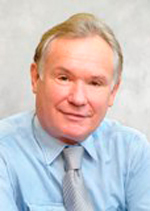David N. Payne: Difference between revisions
No edit summary |
No edit summary |
||
| (6 intermediate revisions by 3 users not shown) | |||
| Line 1: | Line 1: | ||
== | {{Biography | ||
|Image=Payne David.jpg | |||
|Associated organizations=DARPA | |||
|Fields of study=Lasers | |||
|Awards=[[IEEE/RSE Wolfson James Clerk Maxwell Award]] | |||
}} | |||
An internationally renowned photonics engineer, David Payne’s innovations have revolutionized high-speed and long-distance optical communications by providing the ability to efficiently transfer vast amounts of data over large distances. With pioneering fiber fabrication research spanning 40 years that has impacted practically all of today’s optical fiber technology, Dr. Payne’s most crucial innovations were the development of the end-pumped fiber laser and the erbium-doped fiber amplifier (EDFA) during the 1980s. | |||
Still by far the most successful optical amplifier, the EDFA, pumped by a tiny diode laser, allows the optical signals carrying Internet data to be periodically boosted within the fiber itself. This eliminated the need for expensive, capacity-choking, electronic signal regenerators and allowed today’s optical fiber transmission systems to span oceans without regeneration and with vast bandwidth. Dr. Payne’s work made massive deployment of optical fiber networks cost effective, and the EDFA became a key enabling technology that led to the explosive growth of the Internet. | |||
Dr. Payne also made ground-breaking contributions to spun fibers for control of dispersion currently used in undersea fiber cables, the erbium/ytterbium cladding-pumped fiber amplifier used for cable television distribution, the distributed fiber temperature sensor used in oil wells and offshore wind farms, the “bow-tie” polarization-maintaining fiber used in many aircraft/spacecraft navigation gyroscopes, and the fiber preform analyzer used throughout modern fiber factories. Dr. Payne was also the first to identify the bandwidth advantage of the 1.3-μm wavelength window. | |||
Dr. Payne also conducted research for the US Defense Advanced Research Projects Agency (DARPA) during 2000–2004, which included ideas for using parallel, beam-combined laser circuits for missile defense and demonstrated the first kilowatt fiber laser. This technology is now being explored for the next generation of particle accelerators at CERN. Dr. Payne’s current research focuses on high-power industrial fiber lasers for cutting, welding, and marking as an alternative to conventional lasers. | |||
[[Category: | An IEEE member and Fellow of the Royal Academy of Engineering (UK), the Royal Society (UK) and the Russian Academy of Sciences, Dr. Payne is the director of the Optoelectronics Research Centre at the University of Southampton, Hampshire, UK. Payne was the recipient of the 2014 [[IEEE/RSE Wolfson James Clerk Maxwell Award]]. | ||
[[Category: | |||
{{DEFAULTSORT:Payne}} | |||
[[Category:Fiber_optics]] | |||
[[Category:Lasers,_lighting_&_electrooptics]] | |||
[[Category:Optics]] | |||
[[Category:Photonics]] | [[Category:Photonics]] | ||
Latest revision as of 16:33, 21 January 2016
- Associated organizations
- DARPA
- Fields of study
- Lasers
- Awards
- IEEE/RSE Wolfson James Clerk Maxwell Award
Biography
An internationally renowned photonics engineer, David Payne’s innovations have revolutionized high-speed and long-distance optical communications by providing the ability to efficiently transfer vast amounts of data over large distances. With pioneering fiber fabrication research spanning 40 years that has impacted practically all of today’s optical fiber technology, Dr. Payne’s most crucial innovations were the development of the end-pumped fiber laser and the erbium-doped fiber amplifier (EDFA) during the 1980s. Still by far the most successful optical amplifier, the EDFA, pumped by a tiny diode laser, allows the optical signals carrying Internet data to be periodically boosted within the fiber itself. This eliminated the need for expensive, capacity-choking, electronic signal regenerators and allowed today’s optical fiber transmission systems to span oceans without regeneration and with vast bandwidth. Dr. Payne’s work made massive deployment of optical fiber networks cost effective, and the EDFA became a key enabling technology that led to the explosive growth of the Internet.
Dr. Payne also made ground-breaking contributions to spun fibers for control of dispersion currently used in undersea fiber cables, the erbium/ytterbium cladding-pumped fiber amplifier used for cable television distribution, the distributed fiber temperature sensor used in oil wells and offshore wind farms, the “bow-tie” polarization-maintaining fiber used in many aircraft/spacecraft navigation gyroscopes, and the fiber preform analyzer used throughout modern fiber factories. Dr. Payne was also the first to identify the bandwidth advantage of the 1.3-μm wavelength window.
Dr. Payne also conducted research for the US Defense Advanced Research Projects Agency (DARPA) during 2000–2004, which included ideas for using parallel, beam-combined laser circuits for missile defense and demonstrated the first kilowatt fiber laser. This technology is now being explored for the next generation of particle accelerators at CERN. Dr. Payne’s current research focuses on high-power industrial fiber lasers for cutting, welding, and marking as an alternative to conventional lasers.
An IEEE member and Fellow of the Royal Academy of Engineering (UK), the Royal Society (UK) and the Russian Academy of Sciences, Dr. Payne is the director of the Optoelectronics Research Centre at the University of Southampton, Hampshire, UK. Payne was the recipient of the 2014 IEEE/RSE Wolfson James Clerk Maxwell Award.
